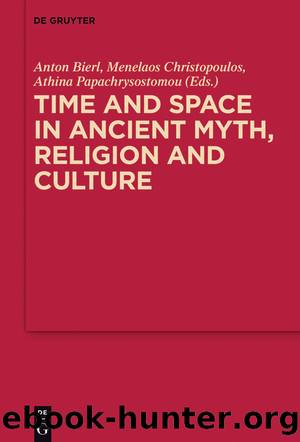Time and Space in Ancient Myth, Religion and Culture by Anton Bierl Menelaos Christopoulos Athina Papachrysostomou

Author:Anton Bierl, Menelaos Christopoulos, Athina Papachrysostomou
Language: eng
Format: epub
Publisher: Walter de Gruyter
Published: 2017-02-15T00:00:00+00:00
Giuseppe Zanetto
Fighting on the River: The Alpheus and the âPylian Epicâ
In the Iliad the old Pylian king Nestor talks on several occasions about his past glorious deeds.645 Many scholars think that these passages are what survives of a âPylian Epicâ, i. e. of the epic songs which in Mycenaean age celebrated the lords of Pylos.646 It is assumed in fact that there was Mycenaean epic poetry, which was performed at the courts of the kings on the occasion of festive or funeral banquets;647 and that this poetry has been almost completely lost, the only exception being the Pylian songs which were incorporated into our text of the Iliad. The survival of the âPylian Epicâ must probably be connected with the important role that many families of Pylian origin played in archaic Greece. In archaic Athens some of the most powerful γένη claimed descent from Neleus and the Neleids. In the cemetery of the Ceramicus the excavations have brought to light geometric funerary vases, produced at the end of the VIII century BC, which reproduce the fight between Nestor and the Moliones.648 We can hypothesise that the mythical episode which was depicted on the vases containing the ashes of the deceased corresponded to a poem performed by a singer during the funeral. If this is so, this means that in geometric Athens the epic tradition originating from Pylos still survived, was still performed and was a key-element in the creation of identity.649
Now, if we look at the content of Nestorâs speeches, we see that he praises victories in battles against neighbouring peoples (Epeans, Arcadians), successful cattle raids, victories in athletic contests and in particular in chariot races. Let us have a short review of these narratives.
Iliad 11.670 â762 offers the most extended passage of âPylian Epicâ. Nestor tells a very complicated story which can be divided in two main sections.650 In the first one he reports how he seized a huge number of cattle, fighting against the Epeans and killing Itymoneus, and how he drove this booty down to Pylos, where on the day after it was divided among the Pylians. Neleus takes the major portion for himself, in retaliation for the loss of his four race-horses, stolen from him by the Epean king Augeas. In the second section Nestor tells how the Epeans came down towards Pylos to take revenge and how the Pylians, warned by Athena, left their city and marched out against the enemies: here the tale is very rich in topographic details, so that it is not difficult to reconstruct the geographic setting.
1. The Epeans move to the river Alpheus, which marks the border of the Pylian territory, and attack Thryoessa.
Iliad 11.711â713:
á¼ÏÏι δέ ÏÎ¹Ï ÎÏÏ á½¹ÎµÏÏα Ïá½¹Î»Î¹Ï Î±á¼°Ïεá¿Î± κολώνη
Ïηλοῦ á¼Ïâ ᾿AλÏειῷ, νεάÏη Î á½»Î»Î¿Ï á¼ Î¼Î±Î¸á½¹ÎµÎ½ÏοÏ
Ïὴν á¼Î¼ÏεÏÏÏαÏá½¹ÏνÏο διαÏÏαá¿Ïαι μεμαῶÏεÏ.
Now there is a city Thryoessa, perched on a steep cliff, overlooking the Alpheus, on the far border of sandy Pylos, and there they camped, aiming to destroy it.651
2. The Pylians set out; the cavalry in a few hours reaches the river Minyeios (a minor stream, presumably flowing about 20 kilometres south of the Alpheus).
Download
This site does not store any files on its server. We only index and link to content provided by other sites. Please contact the content providers to delete copyright contents if any and email us, we'll remove relevant links or contents immediately.
| Anthropology | Archaeology |
| Philosophy | Politics & Government |
| Social Sciences | Sociology |
| Women's Studies |
The Leavers by Lisa Ko(6473)
Born to Run: by Christopher McDougall(6260)
iGen by Jean M. Twenge(4702)
Sapiens by Yuval Noah Harari(4537)
The Kite Runner by Khaled Hosseini(4435)
Spare by Prince Harry The Duke of Sussex(4197)
Bullshit Jobs by David Graeber(3180)
Livewired by David Eagleman(3122)
Goodbye Paradise(2963)
Never by Ken Follett(2880)
A Dictionary of Sociology by Unknown(2518)
Harry Potter 4 - Harry Potter and The Goblet of Fire by J.K.Rowling(2416)
The Club by A.L. Brooks(2360)
People of the Earth: An Introduction to World Prehistory by Dr. Brian Fagan & Nadia Durrani(2346)
The Social Psychology of Inequality by Unknown(2311)
Machine Learning at Scale with H2O by Gregory Keys | David Whiting(2291)
Harry Potter and the Order of the Phoenix (5) by J.K. Rowling(2227)
0041152001443424520 .pdf by Unknown(2220)
Don't Sleep, There Are Snakes by Daniel L. Everett(2217)
